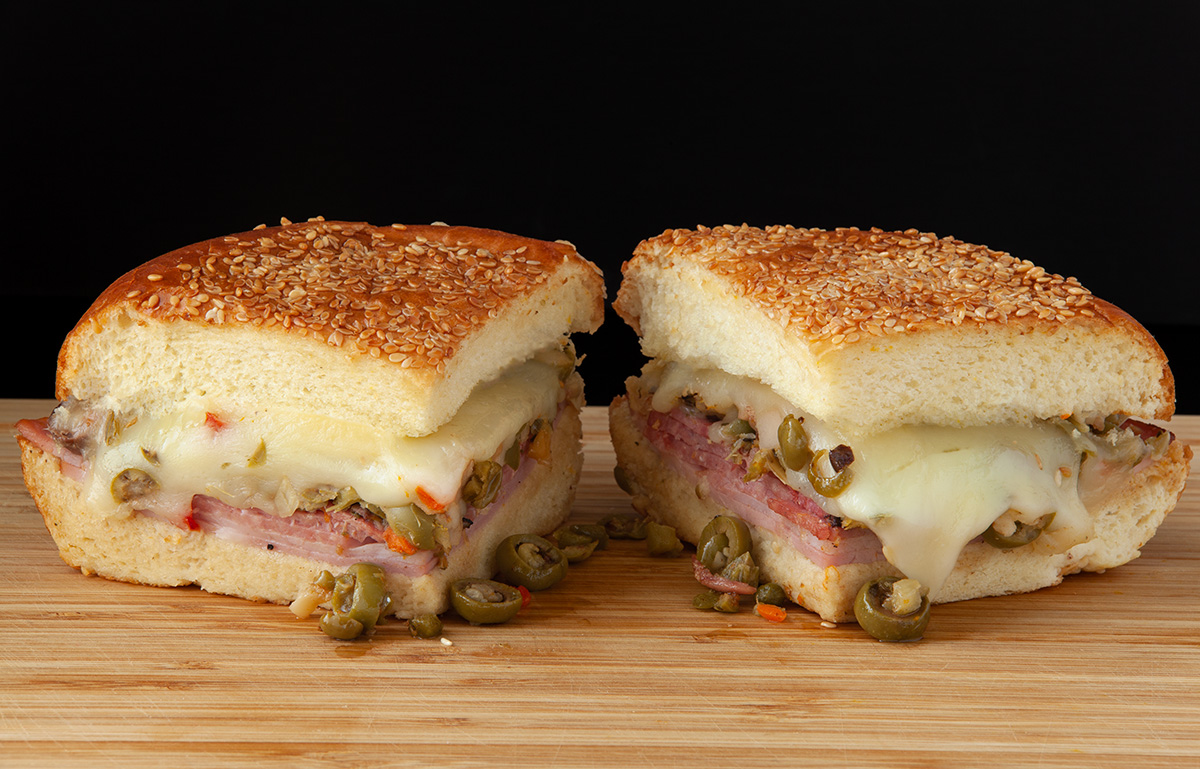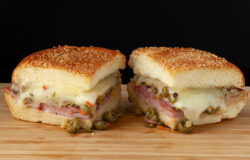Muffuletta Sandwich
The muffuletta–a mammoth sandwich of round sesame bread layered with Genoa salami, ham, mortadella, cheese, and olive salad–is a signature dish of New Orleans.

The Louisiana Endowment for the Humanities
A muffuletta sandwich, 2023. Melissa Carrier, photographer.
The muffuletta—a mammoth sandwich of round sesame bread layered with Genoa salami, ham, mortadella, cheese, and olive salad—is one of New Orleans’s signature dishes. Clearly, the muffuletta is Italian in its ingredients, and yet the sandwich does not exist in Italy. Instead, it is a New Orleans tradition, born and bred in the city, and a testament to the Sicilian community that settled there in the late 1880s and early 1900s. Farmers, vendors, dockworkers, and street hawkers set up shop close to the French Market in an area that became known as “Little Palermo.” At the turn of the twentieth century, there were more than a dozen macaroni factories, several Italian bakeries, and a multitude of importers and small grocers in the neighborhood. It was the symbiotic relationship between these people, their recipes, customs, and traditions that shaped the story of the muffuletta.
First Came the Bread
Muffaletta, muffuletto, muffulettu, muffalatta, or muffolettu? There are several ways to pronounce and spell muffuletta. Some theories on the variations are that they stem from the Italian word muffa (mold) or, more likely, from the Latin term muffula (small sack or mitten).
“Muffuletto” first entered the New Orleans lexicon not as the name for the sandwich but for the type of bread. It seems likely that the sandwich eventually took its name from the bread that is its foundation. Gene Bourg, a former food critic for the Times-Picayune, claimed in a 1988 article that the name transferred due to the practice of reusing the labeled paper. Even today, the custom of wrapping a quartered muffuletta sandwich in the leftover bread paper is sometimes still used.
The muffuletto loaf came to New Orleans from Sicily, where it is associated with religious festivities such as St. Martin’s Day, All Souls’ Day, or the Eve of the Immaculate Conception. The loaves are characterized by a soft and spongy interior and light crust. Most are large, round, often flattened and, like New Orleans’s own muffuletto loaf, come topped with aromatic seeds, such as sesame or fennel.
These traditional golden loaves are perfect for filling. Early advertisements from importers show that the ingredients needed to make a muffaletta sandwich were readily available in the French Quarter at the turn of the century. Yet the first filled muffuletto loaves in New Orleans probably looked and tasted more like those found in Sicily—seasoned with olive oil or lard, olives, oregano, anchovies, and ricotta or caciocavallo cheese. Smaller seeded rolls were also used to make a spleen sandwich called a “vastedda,” which is still eaten in the markets of Palermo today but has disappeared from New Orleans’s culinary landscape.
Central Grocery and the “Original” Muffuletta
There are as many legends about the origins of today’s muffuletta sandwich as there are ways to pronounce it. The most common theory is that it originated in 1906 at Central Grocery (923 Decatur Street in the French Quarter) by owner Salvatore Lupo. According to his daughter, Marie Lupo Tusa, “At lunchtime farmers would go to my father’s grocery and would buy small quantities of Italian cold cuts, cheese, and olive salad. My father also sold a round, puffy, Sicilian-style bread called muffuletta that was baked in small quantities by a Sicilian baker in the neighborhood. In the beginning, the farmers ate the bread along with the cold cuts, cheese, and olive salad. Eventually, my father suggested to his customers that he put it all together as a sandwich for them. The sandwich was referred to as a muffuletta because that was the name of the bread. In Sicily, there was no such thing as a muffuletta sandwich—only the muffuletta bread.”
The Muffuletta Man
Much of what we know about the muffuletta’s early years are based on oral histories and memories passed down through generations. One of the more colorful legends is that of the “muffuletta man.” Just as other roving vendors hawked their wares in the French Quarter, Sicilian bakers sold bread, sfincione (a type of flatbread with tomatoes and anchovies), and muffulettas from pushcarts or baskets. These vendors would yell, “muffuletto, caldo, caldo!” It is unclear from these accounts if the muffulettas sold on the streets were filled sandwiches or just bread.
One story is of a baker named Tony Lovoi, who is reported to have sold muffuletta sandwiches wrapped in the pages of the newspaper from his pushcart. According to his great nephew, Lovoi began making these sandwiches in 1901. There is no historic proof for this version; however, there is record of a bakery—Joseph Lovoi and Company—in the 1910 city directory, at 513 St. Philip Street.
In a later account of a “muffuletta man,” John Ferrara, former co-owner of Ferrara’s Treme Market, tells of seeing the muffuletta man when he was growing up in the French Quarter in the early 1930s. According to Ferrara, “Everyone knew when Frank Di Nicola was coming, and they stood on their front porches waiting for him. By the time he’d gone two blocks, he’d have sold them out. So he’d go back and get another basket. By seven (in the evening), everyone who wanted one for supper had one. They were filled with the best ham, cheese, salami, and olive salad.”
The Muffuletta Appears on the Menu
Prior to the mid-1950s, the muffuletta sandwich does not appear on written menus. The lack of the name’s early mention does not mean that the sandwich didn’t exist: it either had no name or existed under a different one. Some residents of the French Quarter remember asking for an “Italian Sandwich” at Central Grocery or at the neighboring Progress Grocery. Montalbano’s Delicatessen at 724 St. Philip Street sold a sandwich called the “Roman” or “Roma.” Clearly a muffuletta, the sandwich was described as an enormous round sandwich, made to order on a scale, with however much cold cuts, cheeses, or olive salad a customer requested.
By the 1970s, the muffuletta was clearly established on the local and national food scene, as it was listed on menus and discussed in the media. This humble sandwich—a must-eat for tourists and the cause of cravings for many locals—stands as a reminder of the vibrant and important Sicilian community that helped to create New Orleans’s rich and layered history.
